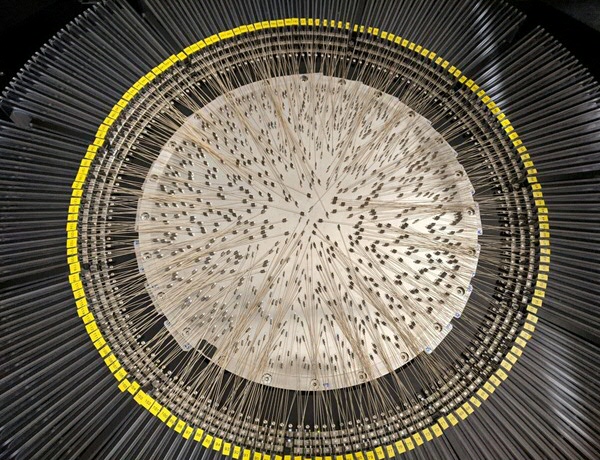Ingenieuze 'geweven' spectrometer bijna klaar voor de start
WEAVE, een ingenieuze spectrometer met duizenden verplaatsbare glasvezels, is bijna klaar voor gebruik door sterrenkundigen. Dat meldt een team van astronomen en technici onder leiding van Scott Trager (Rijksuniversiteit Groningen). De spectrometer, inclusief de twee robots die de glasvezels in wisselende opstellingen leggen, is succesvol geïnstalleerd op de Nederlands-Britse-Spaanse William Herschel Telescope op La Palma.
Tweeduizend verplaatsbare glasvezels
WEAVE staat voor WHT Enhanced Area Velocity Explorer en is een deels in Nederland gemaakte spectrometer. Het instrument kan meer dan 900 sterren of sterrenstelsels tegelijk in de gaten houden. Het rafelt met hoge precisie sterlicht uiteen in duizenden afzonderlijke kleuren. De kern van WEAVE bestaat uit bijna 2.000 verplaatsbare glasvezels. De losse glasvezels worden zo geplaatst dat ze elkaar niet storen. Van een afstandje heeft het veel weg van een kantkloswerk of een weefgetouw, vandaar ook de naam WEAVE. Met WEAVE kunnen astronomen de vorming van sterren bestuderen en onderzoeken hoe sterrenstelsels en het heelal veranderen.

Vorming Melkweg
"We zijn ontzettend opgetogen dat WEAVE nu bijna klaar is voor echte waarnemingen," zegt Scott Trager (Kapteyn Astronomisch Instituut, Rijksuniversiteit Groningen). Trager is de wetenschappelijk projectleider van WEAVE en de voorzitter van het WEAVE Survey Consortium dat overzichtsstudies van het heelal moet opleveren. "Vanwege reisbeperkingen door de coronapandemie duurde het allemaal wat langer dan gepland, maar nu kunnen we echt van start." WEAVE zal de komende vijf jaar tientallen miljoenen spectra van sterren en sterrenstelsels genereren. De gegevens van WEAVE kunnen bijvoorbeeld worden gekoppeld aan de dataverzamelingen van de LOFAR-telescoop en van de ruimtesatelliet Gaia. Daardoor krijgen astronomen meer inzicht in hoe onze Melkweg is gevormd, hoe de sterren daarin zijn geëvolueerd, hoe andere sterrenstelsels zijn samengesteld.
Diverse onderdelen
De spectrometer bestaat uit diverse onderdelen. De zogeheten primaire focuscorrigeerder (prime-focus corrector) zorgt ervoor dat elke glasvezel meer dan 80% van het sterlicht binnenkrijgt. De vezelplaatser (fibre positioner) bestaat uit twee robots die de meer dan 900 glasvezels binnen een uur in de gewenste opstelling leggen. Twee camera's met elk 12.000 bij 6.000 pixels verzamelen de uiteindelijke spectra. Twee cryostaten met vloeibare stikstof koelen de digitale camera's zodat geen beeldvervormingen ontstaan. Eind 2020 waren de meeste onderdelen aangekomen op het Canarische eiland La Palma. Door reisbeperkingen vanwege corona heeft dat langer geduurd dan verwacht. De afgelopen maanden voerden de sterrenkundigen standaardtests en simpele waarnemingen uit. De komende twee à drie maanden volgen de wetenschappelijker waarnemingen tijdens de zogeheten science-verification-tests. Daarna kunnen astronomen uit de hele wereld van de telescoop gebruikmaken.
Meer informatie
Meer nieuws
-
11 december 2025
Stormachtige planeten en een onverwachtse atmosfeer
-
09 december 2025
RUG-hoogleraar bij COP30: ‘Het is altijd drama’
